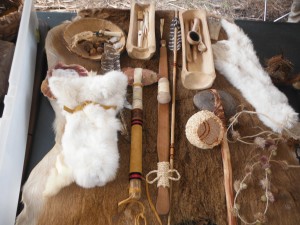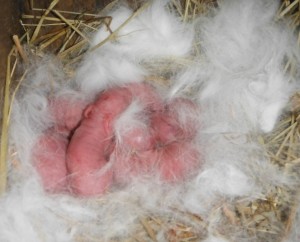The weather has eased away from the oppressive heat that makes having a fur coat unpleasant, and being pregnant downright miserable. So I opt to stop breeding my rabbits in the heat of summer. Since the weather has eased, approximately 30 days ago, I bred two of my does to my AlTex Buck.
AlTex is a terminal sire breed, a breed raised for the sole purpose of using the males as breeding stock to produce hybrids. In the case of AlTex rabbits, when crossed with New Zealand rabbits (and others I’m told), they produce offspring that grow out to harvest size a week earlier than straight breeds or other crosses, such as New Zealands + Californians. This increases each doe’s production by an entire litter per year. What this means to me is the feed costs get cut by almost 1/4 if I harvest at 7 weeks.
At seven weeks of age, my rabbits dress out to about 3 pounds or meat fat, and bones. I find that to be about optimal. Occasionally, I’ll leave the rabbit whole, either for smoking, or as a request from someone. Usually, I’ll simply cut them into manageable portions. Each animal provides two loins (boneless strips from the back – The Primo Cut of meat from a rabbit), two front shoulders, and two “hams”, plus trimmings as well as the heart, liver, and kidneys. Being a Primal (“Paleo”) eater, I always eat those three organs. On a typical harvest day, I dispatch, clean, dress, and quarter four rabbits. I vacuum seal anything I don’t immediately consume, so the typical packaging breakdown is:
- 4 Front Shoulders (x2)
- 2 Hams (x4)
- 4 loins (x2)
- 2-3 pounds of trimmings
This gives me 8 packages of top-quality rabbit to freeze, trade, or give away.
I take the hearts, kidneys, and livers and turn them into a loose breakfast sausage that my 9-year old raves about. (She won’t eat pineapple, but loves this stuff…go figure!) This is usually eaten within a few days, so is rarely packaged.
The trimmings are either added to the sausage, or vacuum sealed and kept for later to be either made into jerky or a cured sausage.
 The hides and feet are frozen and given to Hank at Green Earth Survival School to be made into primitive craft items. If you’ve seen his tanned rabbit hides, you are looking at rabbits I raised. (See some to the right)
The hides and feet are frozen and given to Hank at Green Earth Survival School to be made into primitive craft items. If you’ve seen his tanned rabbit hides, you are looking at rabbits I raised. (See some to the right)
The remaining entrails, as well as the head, usually go to the trash, though the chickens take whatever I drop in their general area. The chickens know when its harvest time, and gather around for any treat they can get. You do know that chickens are omnivores, don’t you? They will eat grains, plants, insects, and if given the chance, each other. Chickens are far closer to velociraptors than I care to think about.
Earlier, I mentioned “approximately 30 days ago”. I said that because when I got home from work today, I found this in one of the nest boxes, two days early:
Momma and the babies all seem fine though, early or not. It is strange, considering this doe was bred AFTER the other doe.
And oddly enough the other doe is just now building her nest and showing signs that things are going to happen in a day or two. Weird!
So Wabbit Breeding Season is upon us! Visions of rabbit jerky dance in my head! Breakfast liver sausage for everyone! Hasenpfeffer! Grilled rabbit! And my favorite (Thanks again, SB!) SMOKED rabbit!
MmmmMmMmmmmmm!…tastes like chicken…only BETTER!
Peace,
db


Wonderful! I’ve been reading your blog with great interest, looking forward to the day when my husband and I will be out of this apartment, and in a place where we can raise plants and critters!
Would you share the recipe for your offal breakfast sausage? (or general instructions, if it’s not that scripted?)
I had read somewhere that good hides required older rabbits, and good meat required younger rabbits… but the hides in the picture look strong and serviceable at seven weeks.
Thanks for the kind words! Comments like this keep me writing
Apartment-dwellers CAN grow their own food, just in smaller quantities… A Rubbermaid tote makes a pretty decent grow bed for lettuce! I actually have several in my yard that do wonderfully, though I’ve modified them to be self-watering, like the Earthboxes, only not nearly as expensive.
Another option is to see if their is a community garden in your area, many towns are starting to have these, and if yours doesn’t, see about starting a program! And you can always try to find someone already with a garden that would rent/share some space. Farmer’s markets would be a decent place to start in your search…
Raising animals is a LOT harder to do as in an apartment. However, if you can have birds, coturnix quail can pass as “pets” while providing meat and eggs…and take up very little space.
(This is turning into a post on its own!)
We call it “Liver sausage”, though it contains a few other organs. I used to grind it , but found that to be a lot of work for a few rabbits, so tried simply rough-chopping each organ into as small a dice as I can stand to do, then mixing it with Publix season salt, some sage, and some oregano. Its not a cured product, so you need to eat it rather quickly. I fry it in lard or butter, brown it up on each side, then step back and watch the nine-year old scarf it down. As far as recipe goes, I simply put in whatever flavors I like, or the daughter requests. Its a journey, not a destination!
Rabbit hides. Yes, the older the rabbit, the thicker the skin, thus the stronger the leather made. And as you said, younger rabbits make for more tender meat. While 7 weeks is optimal for meat, it tends to make for thin skins for tanning. Luckily, I usually have so many rabbits I need to harvest, many get a “stay of execution” for several weeks (sometimes months!), making for a thicker hide…and become somewhat tougher, though in truth, how tough can you get when you never have to run from a predator, and your exercise is three hops to the feeder, play a little bit with your siblings, then sleep until you are hungry again?
I’ve waited as long as 4 or 5 months, usually trying to see it they will make decent breeders, before harvesting, and once I harvested a nasty doe that attacked me every time I tried to touch her. She was over a year old, but made some mighty fine sausages!
I find the older rabbits to still be rather tender, and yield a larger carcass and thicker hide. I pay for it in higher feed bills though. I guess you could say that there is no real winning situation, but there also isn’t really any downside either, it all works out, as long as they aren’t 2 year old rabbits.
Hope that helps!
db
Very cool…I will be looking forward to video of all the recipes, and future rabbit updates…;-)
I would be interested in seeing a video of one dressed, I haven’t done it since I was a kid.
I am working on a “First time dispatching and dressing a Muscovy duck” video right now.
Will add a “dispatching and dressing a rabbit” one also.
BTW, we ended up with 11 new rabbits over the weekend, one doe with 3, the other with 8. Since they were born a few days apart, I took three from the larger litter and put them with the smaller one to “even out the workload”, you could say. I’m not very happy with the doe that only had three kits, NOT a good production number. However, she is my senior doe, and a great mother, so I’ll give her a couple more tries…otherwise, she serves the cause better as sausage
I read somewhere that when they only produce 3-4 rabbits, only one side of their reproductive system is working, not sure though.
But you have 11 more than me….:-)
Can’t wait for the video.
This doe has performed well before,so I’ll be giving her another chance or two…and it will take me some time to replace her also….so 3 kits in a litter is better than no kits for 4 months…
On to the video editing!
My grandpa fed his flemish giants mostly swiss feed beets with some alfalfa pellets and hay on the side but thinking of growing those next year to save on pellets
By not using pellets, you can save money, but sacrifice in the time it takes to grow out. I wrote about feeding local growth to cut my feed bills, and it DOES work…
There is a local breeder that has Flemish Giants along with New Zealands, and loves them both, but says it takes almost twice as long for the Flemish to grow out. This makes them a less efficient producer. The Flemish do offer a larger, thicker hide though….ah trade-offs!
Ultimately, they are all made of meat, so the end product, food-wise, is roughly the same.
And if you are only raising them as pets, then it really doesn’t matter.
Thanks for the comments!